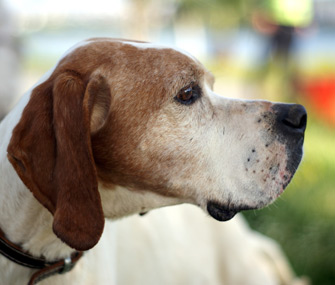Common Behavior Problems in Senior Dogs
Published on May 07, 2012

Older dogs, like older people, may experience sensory or cognitive losses. Fortunately, dogs deal well with these changes — better, in fact, than most people do. The most common sensory loss is loss of hearing. The ability to hear high-pitched sounds usually goes first, so try to call out in a lower tone voice. Dogs can easily learn hand signals, and they can also learn to come to a flashing porch light when out in the yard. Be sure to pet your deaf dog a lot; otherwise, he must wonder why you quit talking to him.
How to Keep Your Old Dog Young at Heart
Dogs, like many animals, naturally show age-related declines in mental function starting at about 6 years of age, but it's usually not noticeable until older age. However, studies have shown that you may be able to counteract this decline somewhat by providing an enriched environment (consisting of social interaction, physical exercise, novel toys, and learning tasks). Each thing helps, but all of them together helps the most. The longer you provide these, the better your older dog might be compared to other old dogs of a similar age. Just because your old dog is not as active as he once was is no reason to think he doesn’t still need stimulation.
Older dogs may not be able to run and jump and do the physical things they could when younger, but they still need low-impact exercise like walking, and they need mental stimulation. If he enjoys the same games he did when he was younger, great! Just be sure not to overdo them, and talk to your veterinarian about joint supplements or other strategies for helping your dog stay active. Your dog may prefer less strenuous activities though. Hide treats around the room and challenge him to find them. Take him for rides in the car; just because he might not be as demanding as he used to be doesn’t mean he doesn’t want to go.
Cognitive Dysfunction Syndrome in Senior Canines
If you find your older dog walking around aimlessly, pacing back and forth, barking randomly, or standing in a corner looking like he’s stuck, he may be suffering from cognitive dysfunction syndrome (CDS). With CDS, the dog may forget he’s house-trained, get stuck behind furniture, stare into a room as if he’s forgotten where he is, bark for no apparent reason, fail to recognize familiar people, or pace around, especially in the evening. In one study, two thirds of dogs between 11 and 16 years of age showed at least one sign of CDS.
The brains of dogs with CDS show similar, but not identical, changes as those seen in human Alzheimer patients. These include deposits of beta-amyloid and the formation of plaques in the brain.
How Your Veterinarian Can Help
Where indicated, your veterinarian can prescribe medication that can help control the signs of CDS in many dogs. After a month of daily treatment, about 75 percent of dog owners report improvement in at least one sign of CDS in their dogs. About one third showed dramatic improvement, one third showed mild improvement, and one third showed little to no improvement.
Loss of house-training can be due to CDS, but it can also stem from physical problems. Older dogs may lose sphincter control, especially while sleeping, and may drip urine or expel feces in their bed. Urinary incontinence in spayed females, especially larger-size females, may be related to hormones and may be treatable. Ask your veterinarian about drug therapy. In other cases the best you can do is use the puppy training pads, or pads made for incontinent people, where your dog sleeps. Use rinse-free shampoo to keep the dog clean.
Sometimes loss of house-training can be caused by diseases such as diabetes or kidney disease that make the dog have to urinate more, or by urinary tract diseases that make the dog feel the urgent need to urinate often. Don't attribute lack of house-training — or any behavioral changes in your older dog — to CDS before first having your veterinarian look for other reasons.





